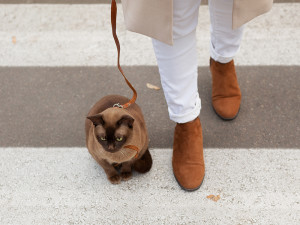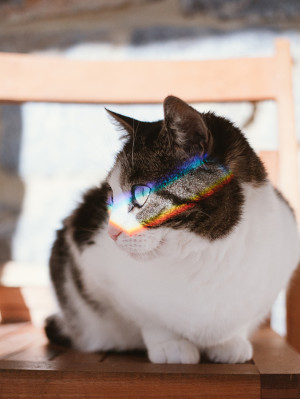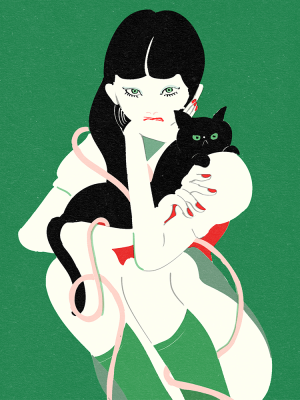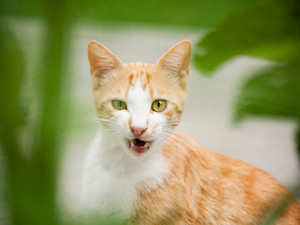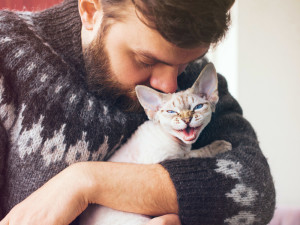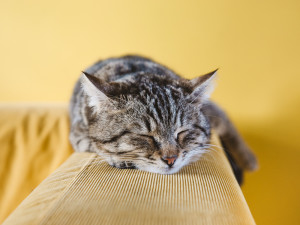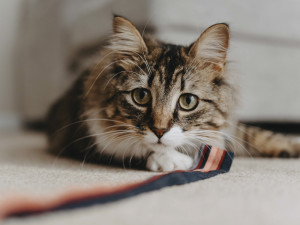10 Common Cat Myths (That Are Actually False)
Peel back the layers of mystery to discover the truth about our feline friends

share article
In the world of feline folklore, myths and misconceptions abound, painting a portrait of cats that often strays far from reality. From superstitions surrounding black catsopens in a new tab, to the age-old belief in their nine lives, these myths have woven themselves into the fabric of the cultural understanding of cats, often with little-to-no evidence behind them.
With their enigmatic personalities and graceful demeanours, cats have captivated humans for centuries (there’s a reason the ancient Egyptians worshipped them, after all), but their mysterious aura and lack of ability to speak (yet…) can leave pet parents wondering what’s really going on inside their adorable heads.
From the origins of the misconception that cats only purr when they are happy, to the truth behind their uncanny ability to always land on their feet, peel back the layers of myth and mystery to reveal the truth about our beloved feline friends.
Cats always land on their feet
Cats are renowned for their remarkable agility and reflexes, earning them a reputation for always landing on their feet. This innate reflex, known as the righting reflexopens in a new tab, allows cats to twist their bodies in mid-air and land on their feet, minimising the risk of injury. However, this does not always mean that cats are immune to harm or that they can survive falls from any height unscathed.
Whilst cats are incredibly agile and possess this remarkable ability to right themselves during a fall, they are not invincible. Accidents can happen, and cats can be susceptible to serious injuries from a high fall, including broken bones, bruises and internal trauma. It’s a misconception to assume that they are immune to harm simply because of their innate acrobatic skills, so ensuring your home is safeopens in a new tab and free of potential hazards (high balconies or ledges, for example) is crucial for preventing any accidents.
You should give your cat cow’s milk
The image of a cat lapping up a saucer of milk is a common trope in popular culture – just think of any cartoon kitty and you’ve probably seen them taking a sip – but the reality is that most cats are actually lactose intolerantopens in a new tab. Like many mammals, kittens produce an enzyme called lactaseopens in a new tab that allows them to digest their mother’s milk. However, as they mature and are weaned on to solid food, their production of lactase decreases, making it difficult for them to digest lactose, the sugar found in milk.
Feeding your cat dairy products can lead to digestive upset, including diarrhoeaopens in a new tab and vomitingopens in a new tab. Whilst some cats may tolerate small amounts of dairy (and even enjoy it), it’s not a necessary part of their diet; it’s best to avoid it altogether and opt for fresh water as their primary source of hydration.
If you’re looking for a special treat for your cat, there are specially formulated cat milk products available that are lactose-free and safe for feline consumption. These products provide a tasty alternative to traditional cow’s milk and can be enjoyed by cats (in moderation, as a treat) without the messy risk of digestive issues.
Cats only purr when they are happy
Purring is one of the most characteristic and endearing behaviours exhibited by cats (especially when you’re lucky enough to be the ‘chosen one’ and get a purring kitty on your lap), but contrary to popular belief, it doesn’t always indicate happiness. While cats often purr when they’re contentopens in a new tab, they may also purr in other situations, such as when they’re feeling anxiousopens in a new tab, stressed or unwell.
In addition to expressing pleasure and relaxation, cats may purr as a means of self-soothing during times of discomfort or pain. The low-frequency vibrations produced by purring have been shown to have a calming effect on both cats and humans, making it a valuable tool for coping with stress and anxiety.
Purring is produced by the rapid contraction and relaxation of the cat’s laryngeal muscles, typically at a frequency of 25–150 Hz. This low-frequency soundopens in a new tab has been shown to have therapeutic effects, both for cats and their human parents. Research suggests that the act of purring can promote healingopens in a new tab, reduce stress and lower blood pressure in both cats and humans.
Pay attention to your cat’s body language and overall behaviour to determine the underlying cause of their purring. Whether it’s providing comfort during a stressful situation or seeking attention and affection, purring is just one of the many ways cats communicate with their human companions.
Cats cannot be trained
Whilst they may not be as eager to please as dogs, cats are intelligent animals with individual personalities and preferences, and are more than capable of being trained. Keep training sessions short, fun and rewarding, and you bet your cat can learn a variety of behaviours through positive reinforcement techniques, such as using treats, praise and play.
Training your cat not only strengthens the bond between you and your pet, but also provides mental stimulation and enrichment for your cat. By harnessing their natural instincts and abilities, you can teach your cat to engage in a wide range of training and tricks. From simple commands such as ‘sit’ and ‘stay’, to more complex behaviours like fetchingopens in a new tab and clicker trainingopens in a new tab, the possibilities are endless when it comes to training your feline friend.
White cats with blue eyes are deaf
Although it’s true that some white cats with blue eyes may be deaf, it is not a universal rule. Deafness in cats is not determined solely by coat colour, but instead by genetics. However, white cats with blue eyes are more prone to congenital deafness due to a genetic mutation linked to coat colour and eye pigment. The gene responsible for white fur and blue eyes is associated with a higher likelihood of inner ear abnormalities, which can result in partial or complete deafness.
If you suspect your cat may be deafopens in a new tab, there are several signs to watch out for, including unresponsiveness to auditory stimuli, excessive vocalisation and difficulty waking from sleep. It’s important to note that not all white cats with blue eyes are deaf, and deafness can occur in cats of any colour or breed. If you notice any of these symptoms in your cat, consult a vet for a proper evaluation and guidance.
Cats can see in the dark
Cats do have excellent night vision compared to humans, but they cannot see in complete darkness. Like us, they rely on some ambient light to navigate their surroundings and see clearly in the dark. Their superior night vision is attributed to special adaptations in their eyes, such as a higher concentration of rod cells that enhance their ability to detect motion and low levels of light.
Cats’ eyes also have a reflective layer called the tapetum lucidum, which enhances their ability to see in low light conditions by reflecting light back through the retina. This unique feature gives cats their distinctive glowing eyesopens in a new tab when illuminated in the dark. While cats may not be able to see in complete darkness, their impressive night vision allows them to huntopens in a new tab and explore their surroundings effectively, even under low-light conditions.
Black cats are unlucky
Let’s address this superstition head-on: black cats are not harbingers of misfortune. The superstition surrounding black cats as bringers of bad luckopens in a new tab is deeply ingrained in various cultures around the world. Historically, black cats have been associated with witchcraft and evil omens, leading to their unjust reputation as symbols of bad luck.
However, this belief is not only unfounded but also unjust to these beautiful creatures; the notion that they bring bad luck is nothing more than an old wives’ tale. In fact, in many cultures, these sleek beauties are revered as symbols of good fortune and prosperity. For example, in ancient Egypt, black cats were revered and considered sacred animals associated with the goddess Bastet, who represented fertility, home and protection.
Despite their unfortunate portrayal in folklore and superstition, black cats are just as loving, affectionate and deserving of a happy home as cats of any other colour. Every cat, regardless of their colour, deserves to be valued and cherished for the unique companionship they provide. Adopting a black cat can bring joy and happiness into your life, while also dispelling the outdated myth of their alleged ‘bad luck‘.
Cats are solitary animals who prefer being on their own
Cats are often portrayed as solitary creatures, but as many pet parents will attest, they are actually quite social animals that form strong bonds with their human caregivers and feline companions. Whilst cats are known for their independent nature, and some may enjoy their alone time more than others, most thrive on interaction and companionship.
Providing opportunities for socialisation and enrichment is essential for promoting your cat’s well-being and preventing boredom and loneliness. Cats are highly territorial creatures, and they may initially be wary of new people or animals entering their environment. However, with patience and proper introductions, most cats can learn to coexist peacefully with others and even form close friendships with other feline housemates.
Cats crave love and attention from their human companions, too. Interactive play sessionsopens in a new tab, environmental enrichment, and plenty of affection and attention (what a shame… more cuddles) can help strengthen the bond between you and your cat, while also providing mental and physical stimulation.
Indoor cats can’t get sick
If your cat has the proclivity to stay indoors (who can blame them), you might think they’re at less of a risk of catching diseases and getting injured. But don’t skip their next vaccination appointment just yet.
Indoor cats may be protected from certain outdoor hazards but they are still susceptible to a variety of illnesses and health issues. From obesity and dental problems to infectious diseases and behavioural issues, indoor cats require just as much veterinary care and preventive measures to maintain their health and well-being as an outdoor cat.
Indoor environments can pose their own set of risks for cats, including exposure to toxic substancesopens in a new tab, household hazards and infectious diseases carried by humans or other pets.
Regular check-ups at the vet, vaccinations, and flea and parasite preventionopens in a new tab along with a balanced diet, regular exercise and mental stimulationopens in a new tab to keep your cat physically and mentally fit are essential components of maintaining any cat’s health.
Cats have nine lives
As the old English proverb goes, “A cat has nine lives: for three he plays, for three he strays and for the last three he stays”, but the metaphorical idea that cats possess nine lives is a charming but fictitious notion that has persisted for centuries. Whilst it‘s not certain where the myth came from, there are a number of possible origins, including as far back as the late 1500s in William Shakespeare’s texts.
In Romeo and Juliet, Mercutio calls Tybalt a rat-catcher and further provokes him by demanding, “Good king of cats, nothing but one of your nine lives, that I mean to make bold withal, and, as you shall use me hereafter, dry beat the rest of the eight.”
An even older theory is that the notion originated in ancient Egypt where cats were revered as divine creatures. Atum-Ra, a sun god who took a feline form for visits to the underworld, gave life to the gods of air, moisture, earth and sky, who, in turn, produced Osiris, Isis, Seth and Nephthys. These gods are known collectively as the Ennead – or the Nine. The Egyptians regarded Atum-Ra, the ‘cat god’, as the embodiment of nine lives in one creator.
This myth has likely been perpetuated from years of watching cats’ remarkable agility and their uncanny ability to escape dangerous situations relatively unscathed. Cats are resilient creatures, with incredible reflexes and instincts that help them navigate their environment with grace and agility. As any kitty parent can attest, cats are skilled climbers, jumpers and hunters, which probably contributes to their reputation for having multiple lives.
However, it’s essential to remember that they are not invincible (as much as they‘d like you to think otherwise). Providing a safe and stimulating environment, regular vet care and check-ups, and plenty of love and attention are crucial for ensuring a long and healthy life for your feline friend.
References:
The felid purr: A healing mechanism? (November 2001)opens in a new tab
Domestic cat larynges can produce purring frequencies without neural input (2023)opens in a new tab
Development and maturation of postural reflexes in normal kittens - ScienceDirectopens in a new tab
The sound of silence | Valeria Higgins | Cat‘s Protectionopens in a new tab

Orla Pentelow
Orla Pentelow is a freelance journalist and copywriter based in London. When not at her desk she’s out and about with her rescue dog, Luna, who works primarily as chief distractor.
Related articles
![A cat outside showing its bottom teeth.]() opens in a new tab
opens in a new tabWhat’s All the Cat Chatter About?
Scientists believe they could be mimicking the calls of their prey
![Kitten scratching fabric sofa]() opens in a new tab
opens in a new tabHow to Stop Your Cat From Absolutely Ripping Apart Your Couch
Placing a cat tree or post in a room only, uh, scratches the surface of solving this problem
![cat meowing]() opens in a new tab
opens in a new tabThe Cat’s Meow – What Does it All Mean?
How to decode your cat’s love language when one meow has many meanings
![Cat napping on a yellow couch against a yellow background]() opens in a new tab
opens in a new tabDoes My Cat Have Spots?
Pimples and spots can be unsightly and painful – here’s how to treat your cat’s acne
![A cute cat laying on the ground with wide eyes]() opens in a new tab
opens in a new tabWhat Your Cat’s Sexy ‘Slow Blink’ Actually Means
Cat behaviourist Cristin Tamburo on how to read cat eyes


